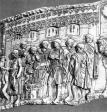|
|
 |
|
Forum, Markets and Column of Trajan |
|
written
by mcwilson / 09.05.2004 |
|
|
| |
Patron |
| |
| |

|
|
| Jupiter Hurls Thunderbolt in Response to Dacians |
|
| |
|
| |

|
|
| Detail of Bridge over the Danube River |
|
| |
|
Whether or not the Forum was originally designed for the purpose of housing Trajan’s mausoleum, it was certainly effective in glorifying his life. The Column certainly depicted scenes from his greatest conquest, the Dacian wars, but it is important to note that the scenes depicted in the frieze very closely portray Trajan’s own account of the wars. The Dacian soldiers are depicted as inferior, with their heads hung low in defeat to the Romans. These illustrations may not have been entirely inaccurate, but certainly depict the Romans as the superior with their victory.
The depiction of the lowered morale of the Dacians follows with one of the major purposes of the Forum. It was built for Roman citizens, for them to make and debate laws in the basilica, trade goods in the market, and for them to socialize in the piazza. As the morale of Roman citizens was based around their superiority over others, it was entirely fitting for their new forum to celebrate their domination over yet another civilization. Trajan did not just have the morale of his citizens in mind when making a point of defending his conquests in Dacia through the new Forum. In AD 113, shortly after dedicating the Column, Trajan initiated another campaign, this time against the Parthians. Cassius Dio, a great Roman historian, later suggested that the Parthian Wars were fought for glory, and not out of necessity. Trajan would have needed to have a significant record for fighting wars for the benefit and gain of the Empire to lead his military into yet another costly war with the support of his people. His record would have been already brilliantly displayed in the Forum with its immortalized illustrations of his previous glories.
Trajan would have enjoyed the liberties of having his previous wars approved, not only by the Roman people, but of the Roman Gods, whose approval was very important to the merit of a conquest. It was important in the depiction of the wars to involve the approval of the gods with scenes of sacrifice. Jupiter confirms his consent for the wars in scene XXIV of the Dacian frieze, pitching his thunderbolt in support of the Romans. The illustrations show a stark connection between the campaigns, and the resources gained from them. A bridge constructed over the Danube River is depicted in scenes XCIX-C to stress the gain of the area once occupied by the Dacians, which was considered Roman territory after the wars. While the frieze carved into Trajan’s column depicts scenes of war, it depicts very few actual battle scenes. This could be construed as an attempt to downplay the gruesome realities of war, and to glorify the aspects of war concerning travel, construction, submission, and sacrifice. This would have been essential in separating the glory of war, which would have been the most profitable as propaganda, to the gruesome realities of the conquests.
|
| |
|
| |
|
|
 |
|

